
Discover the world of wine with simplicity and confidence․ This guide offers a clear starting point for understanding wine basics‚ from tasting techniques to popular varieties‚ making it approachable for newcomers․
What is Wine?
Wine is an alcoholic beverage made primarily from fermented grapes․ Other fruits can also be used‚ but grapes are the most common․ The fermentation process involves yeast converting grape sugars into alcohol‚ creating a wide variety of flavors and aromas․ Wine can range from sweet to dry‚ sparkling to still‚ and varies in color‚ tannins‚ and acidity․ It’s enjoyed globally‚ often paired with food or sipped on its own‚ offering a diverse and rich experience for drinkers of all levels․
Why Learn About Wine?
Learning about wine enhances your dining experiences‚ helping you make informed choices and appreciate its nuances․ Understanding wine improves your ability to pair it with food‚ broadening your culinary horizons․ It also fosters social connections‚ as wine is often shared in gatherings․ Exploring wine expands your knowledge of cultures and regions‚ offering a deeper appreciation for its craftsmanship․ With accessible resources and guides‚ anyone can confidently navigate the world of wine‚ turning it into a lifelong passion and enjoyment․
Basic Wine Terminology
Understanding key terms helps you navigate the world of wine․ Varietal refers to wines made from a single grape type․ Blend combines multiple grapes for complexity․ Vintage indicates the harvest year‚ while appellation denotes the wine’s region․ Aroma describes scents‚ and finish refers to the aftertaste․ Terms like crisp‚ smooth‚ or oaky describe textures and flavors‚ aiding in communication and exploration of wines effectively․
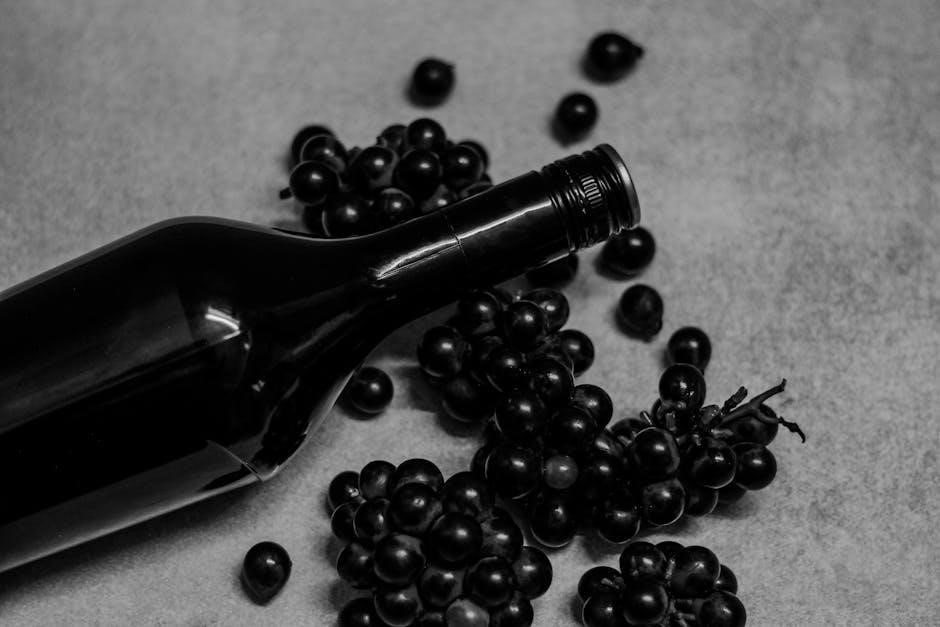
Understanding Wine Labels
Wine labels provide essential information about the wine‚ including its origin‚ grape variety‚ and vintage․ Key terms like appellation and producer indicate quality and source‚ helping you make informed choices․
How to Read a Wine Label
Reading a wine label can seem overwhelming‚ but it’s simpler than you think․ Start by identifying the wine producer and region‚ which indicate origin and quality standards․ Next‚ note the grape variety or blend‚ as this determines the wine’s flavor profile․ The vintage refers to the harvest year‚ while terms like appellation or DOC signify regional certification․ Some labels also include flavor descriptions or awards‚ helping you make informed choices․
Key Information on Wine Labels
Wine labels provide essential details to guide your selection․ The alcohol content indicates strength‚ while sulphite notices inform about additives․ Labels often highlight awards or organic certifications‚ ensuring quality․ Some feature food pairing suggestions or tasting notes‚ helping you match wines with meals․ The producer and region are always listed‚ giving insight into the wine’s origin and style․ These details empower you to make informed decisions and enhance your drinking experience․
Regional Indicators and Classifications
Regional indicators on wine labels reveal the wine’s origin‚ such as Bordeaux or Tuscany‚ influencing its style and quality․ Classifications like Bordeaux’s Grand Cru or Italy’s DOCG rank wines by quality and origin․ These designations ensure authenticity and help consumers understand the wine’s standards․ They often highlight specific grape varieties or production methods‚ providing a guarantee of tradition and quality․ Learning these indicators and classifications can guide beginners in selecting wines from renowned regions with confidence and clarity․

Major Wine Regions
Explore Bordeaux‚ Burgundy‚ Tuscany‚ Rioja‚ Napa Valley‚ and Marlborough—regions shaping wine history with distinct styles‚ terroirs‚ and grape varieties․
Old World Wine Regions
Old World wine regions‚ such as France‚ Italy‚ Spain‚ Germany‚ and Portugal‚ are renowned for their centuries-old winemaking traditions․ France is famous for Bordeaux‚ Burgundy‚ Champagne‚ and Loire Valley‚ while Italy boasts Tuscany‚ Piedmont‚ and Veneto․ Spain offers Rioja and Ribera del Duero‚ Germany is known for Mosel and Rheingau‚ and Portugal for Douro Valley․ These regions emphasize terroir‚ resulting in diverse‚ complex wines․ From Cabernet Sauvignon in Bordeaux to Chianti in Tuscany‚ Old World wines showcase rich history and tradition․
New World Wine Regions
New World wine regions‚ such as the United States‚ Argentina‚ Chile‚ Australia‚ New Zealand‚ and South Africa‚ are known for their innovative winemaking techniques and bold‚ fruit-forward wines․ California’s Napa Valley and Sonoma are famous for Cabernet Sauvignon and Chardonnay‚ while Argentina’s Mendoza is synonymous with Malbec․ Chile’s Maipo Valley produces exceptional reds‚ and Australia’s Shiraz from the Barossa Valley is highly regarded․ New Zealand excels with Sauvignon Blanc‚ and South Africa offers diverse styles․ These regions emphasize accessibility and affordability‚ making them perfect for beginners exploring wine․
Understanding Regional Styles
Regional styles reflect the unique combination of climate‚ soil‚ and winemaking traditions․ Old World regions like Bordeaux and Burgundy emphasize terroir‚ resulting in wines with earthy‚ mineral notes․ New World regions‚ such as Napa Valley and Mendoza‚ focus on bold fruit flavors and smooth tannins․ Understanding these styles helps in selecting wines that suit your taste preferences‚ whether you enjoy the complexity of European wines or the approachable charm of New World varieties․ This knowledge enhances your wine journey and pairing experiences․

Wine Tasting Techniques
Mastering wine tasting techniques is easy! Learn to look‚ swirl‚ smell‚ taste‚ and finish․ These simple steps enhance your appreciation of any wine’s complexity and charm․
The 6-Step Wine Tasting Method
Start by examining the wine’s color and clarity․ Next‚ swirl your glass to release the aromas․ Smell the wine to identify its scents․ Take a small sip‚ letting it coat your palate to experience the flavors․ Pay attention to the finish‚ how long the flavors linger․ Finally‚ consider the overall balance and impression․ This systematic approach helps you fully appreciate the wine’s qualities and nuances‚ making tasting more enjoyable and informative․
How to Swirl‚ Sniff‚ and Sip
Start by swirling the wine in your glass to release its aromas‚ holding the stem to avoid warming the wine․ Next‚ bring the glass to your nose and inhale deeply to identify scents like fruit‚ floral‚ or earthy notes․ Finally‚ take a small sip‚ letting the wine sit in your mouth for a moment to experience its flavors and texture․ These steps help you fully engage with the wine‚ enhancing your tasting experience and making it more enjoyable and informative․
Describing Wine Aromas and Flavors
Start by noting the wine’s color and clarity․ When swirling‚ observe how it clings to the glass․ Smell for aromas like citrus‚ floral‚ or earthy notes․ Taste and describe flavors such as ripe fruits‚ spices‚ or vanilla․ Consider the texture—smooth‚ crisp‚ or silky—and the finish‚ whether lingering or short․ Pairing these observations helps paint a vivid picture of the wine‚ making it easier to share your experience and refine your palate over time․
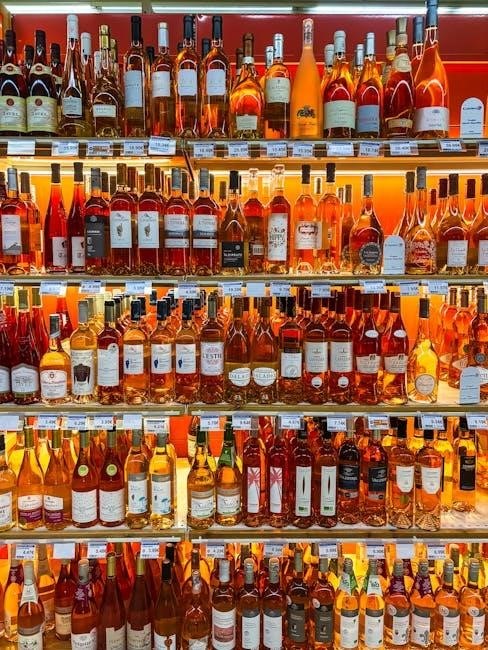
Popular Red Wines for Beginners
Explore smooth‚ approachable reds like Merlot‚ Pinot Noir‚ Cabernet Sauvignon‚ and Malbec․ These wines offer fruity‚ velvety textures perfect for new drinkers‚ making them ideal starting points․
Merlot
Merlot is a smooth and approachable red wine‚ perfect for beginners․ Known for its plum and blackberry flavors‚ it offers a velvety texture with soft tannins․ Easy to drink‚ Merlot pairs well with pasta‚ pizza‚ or grilled meats․ Its balanced acidity makes it versatile for various dishes‚ from casual meals to slightly upscale occasions․ A great starting point for red wine newcomers‚ Merlot is widely available and consistently enjoyable‚ making it a popular choice for everyday drinking․
Pinot Noir
Pinot Noir is a light-bodied red wine with delicate flavors of cherry‚ raspberry‚ and earthy notes․ Its smooth and balanced profile makes it a great choice for beginners․ Pairs well with lighter dishes like salmon‚ poultry‚ or vegetarian meals․ Known for its crisp acidity and subtle tannins‚ Pinot Noir is both refreshing and sophisticated․ Its versatility and approachable nature have made it a favorite among wine drinkers looking to explore red wines without overwhelming their palate․
Cabernet Sauvignon
Cabernet Sauvignon is a full-bodied red wine known for its bold flavors of dark fruit‚ spice‚ and hints of vanilla․ It is one of the most popular red wines‚ offering robust tannins and a smooth finish․ Ideal for pairing with red meat‚ rich dishes‚ or aged cheeses‚ Cabernet Sauvignon is a classic choice for beginners exploring fuller-bodied wines․ Its versatility and widespread availability make it a great starting point for understanding more complex red wines․
Malbec
Malbec is a smooth‚ full-bodied red wine with rich flavors of dark fruit like plum and blackberry․ Its velvety texture and approachable tannins make it a favorite for beginners․ Originating from France but now widely produced in Argentina‚ Malbec pairs perfectly with grilled meats‚ spicy dishes‚ or robust cheeses․ Its bold yet balanced profile makes it an excellent choice for those exploring red wines‚ offering a delicious introduction to fuller-bodied varieties without overwhelming complexity․

Popular White Wines for Beginners
Explore smooth‚ crisp‚ and refreshing white wines perfect for newcomers․ Chardonnay‚ Sauvignon Blanc‚ Pinot Grigio‚ and Prosecco are excellent choices‚ offering fruity and approachable flavors for easy sipping․
Chardonnay
Chardonnay is a popular white wine known for its smooth‚ buttery flavors and aromas of vanilla‚ caramel‚ and tropical fruits․ Its richness makes it a great match for creamy dishes or roasted chicken․ With its approachable taste‚ Chardonnay is ideal for beginners exploring white wines․ It’s widely available and pairs well with a variety of foods‚ making it a versatile choice for any occasion․
Sauvignon Blanc
Sauvignon Blanc is a crisp and refreshing white wine‚ known for its zesty citrus‚ green apple‚ and grassy notes․ Its bright acidity makes it a perfect choice for seafood‚ salads‚ or goat cheese dishes․ With its straightforward flavors‚ it’s an excellent option for beginners looking to explore white wines․ Sauvignon Blanc’s vibrant and clean taste is easy to enjoy‚ making it a popular choice for casual sipping or pairing with lighter meals․
Pinot Grigio
Pinot Grigio is a smooth and versatile Italian white wine‚ offering flavors of lemon‚ lime‚ and honeysuckle․ Its crisp acidity makes it refreshing and easy to enjoy․ Perfect for beginners‚ it pairs well with seafood‚ pasta‚ and salads․ Its light‚ approachable style and wide availability make it a great choice for those exploring white wines․ With its clean finish and subtle fruitiness‚ Pinot Grigio is an excellent introduction to the world of white wines․
Prosecco
Prosecco is a lively and affordable Italian sparkling wine‚ perfect for celebrations or casual sips․ Its flavors of green apple‚ pear‚ and floral notes make it refreshing and approachable․ A great introduction to sparkling wines‚ Prosecco is less complex than Champagne but equally enjoyable․ Pair it with light dishes‚ desserts‚ or enjoy it on its own․ Its crisp acidity and fruity profile make it a favorite for beginners exploring bubbly wines․

Sparkling and Dessert Wines
Sparkling wines‚ like Champagne and Prosecco‚ add festivity with their lively bubbles‚ while dessert wines offer rich‚ sweet finishes․ Both are perfect for special occasions or as a treat․
Champagne vs․ Prosecco
Champagne and Prosecco are popular sparkling wines‚ but they differ in origin‚ taste‚ and price․ Champagne‚ made in France‚ is typically more complex and expensive‚ aged longer for depth․ Prosecco‚ from Italy‚ is fruitier and more affordable‚ aged shorter․ Champagne is often enjoyed at formal events‚ while Prosecco suits casual gatherings․ Both are great for celebrations but cater to different tastes and budgets․
Dessert wines are sweet‚ rich‚ and perfect for ending meals on a high note․ They range from lightly sweet to intensely rich‚ often made from grapes with higher sugar content or special winemaking techniques․ Popular types include Moscato‚ Riesling‚ and Tawny Port․ These wines pair beautifully with fruits‚ cheeses‚ and chocolate‚ offering a luxurious finish to any dining experience․
How to Pair Sweet Wines
Sweet wines like Moscato‚ Riesling‚ and Tawny Port are perfect for balancing rich or sweet dishes․ Pair Moscato with citrus desserts‚ Riesling with spicy foods or cheeses‚ and Tawny Port with chocolate․ Match sweetness levels—light desserts with lighter wines‚ richer ones with sweeter varieties․ Experiment with textures and flavors to create harmonious combinations that elevate both the wine and the dish․
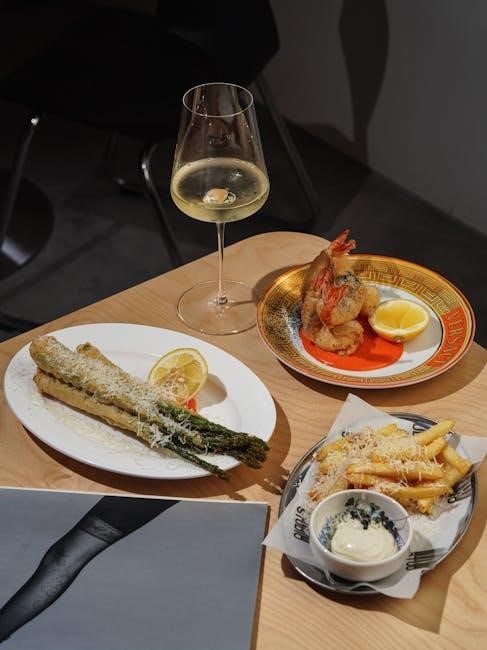
Wine and Food Pairing
Match wine with dishes based on flavor profiles․ Red wines pair well with hearty meats‚ while whites complement lighter fare; Personal taste plays a key role․
General Pairing Tips
Start by matching wine to the main elements of your dish․ Red wines pair well with bold flavors and hearty meats‚ while white wines complement lighter‚ delicate dishes․ Consider tannins‚ acidity‚ and sweetness when pairing․ For example‚ a rich‚ fatty dish pairs nicely with a tannic red wine‚ while crisp whites like Sauvignon Blanc enhance fresh‚ citrusy flavors․ Personal taste matters‚ so don’t be afraid to experiment․ Remember‚ the goal is harmony‚ not perfection․ Always ask for pairing suggestions at wine shops or restaurants for tailored advice․
Classic Red Wine Pairings
Pair bold red wines like Cabernet Sauvignon with red meat‚ hard cheeses‚ or robust dishes․ Merlot complements pasta‚ grilled vegetables‚ and red meat․ Pinot Noir‚ with its light profile‚ pairs beautifully with poultry‚ salmon‚ and earthy mushrooms․ Malbec‚ rich and fruity‚ matches well with grilled meats‚ empanadas‚ and spicy flavors․ These classic combinations offer a reliable starting point for pairing red wines with your favorite meals․
Classic White Wine Pairings
Chardonnay pairs perfectly with roasted chicken or seafood in creamy sauces․ Sauvignon Blanc complements fresh salads‚ goat cheese‚ and citrus-infused dishes․ Pinot Grigio matches well with seafood‚ pasta‚ or vegetarian options․ Prosecco‚ a sparkling choice‚ is ideal for lighter meals or brunch․ These classic pairings provide a reliable foundation for enjoying white wines with a variety of flavors and dishes‚ making your dining experience more enjoyable and balanced․
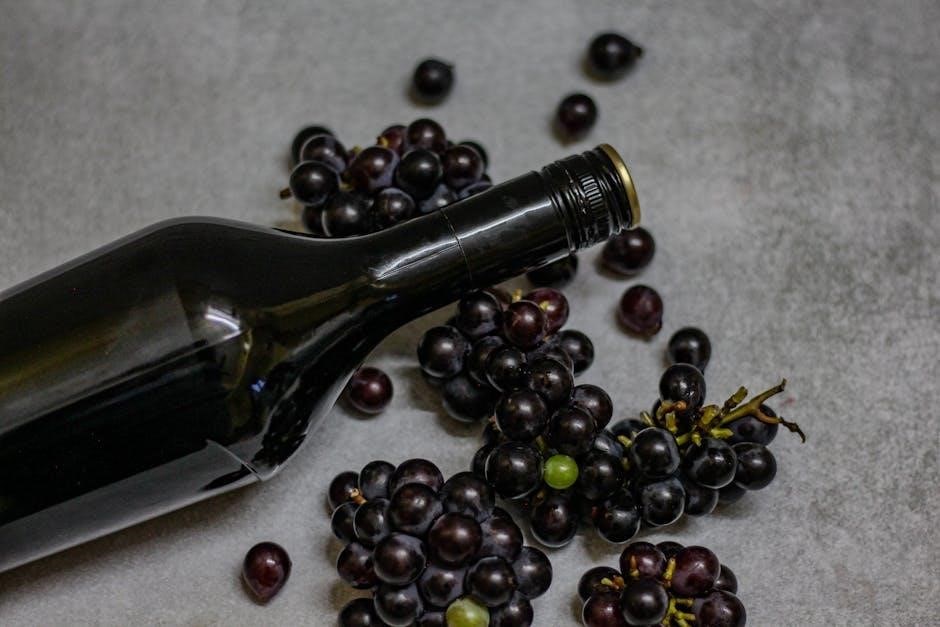
Wine Tools and Accessories
Essential tools like wine glasses‚ corkscrews‚ and decanters enhance your wine experience․ Proper accessories help preserve aromas and flavors‚ ensuring a perfect pour and enjoyment of your wine․
The Right Wine Glasses
Choosing the right wine glasses enhances your tasting experience․ Red wines benefit from larger‚ rounded bowls to release bold aromas‚ while white wines thrive in narrower‚ U-shaped glasses to preserve crispness․ Sparkling wines shine in tall‚ slender flutes to maintain effervescence․ Universal glasses are versatile for everyday use․ Investing in quality glassware elevates both the aroma and flavor of your wine‚ making it a worthwhile investment for any wine enthusiast or beginner exploring the world of wine․
Wine Openers and Corkscrews
A good wine opener or corkscrew is essential for any wine enthusiast․ Popular options include wing corkscrews‚ lever-style openers‚ and automatic electric models․ Ergonomic designs make opening bottles easier and less intimidating for beginners․ Look for tools with durable materials and smooth mechanisms to prevent cork breakage․ Some openers come with foil cutters for convenience․ While screw-top wines are gaining popularity‚ traditional corks remain common‚ making a reliable corkscrew a must-have․ Investing in a quality opener enhances your wine-drinking experience and ensures effortless bottle preparation․
Wine Decanters and Coolers
Wine decanters and coolers are essential tools for enhancing your wine experience․ Decanters separate wine from sediment and aerate it‚ improving flavor and aroma․ Coolers maintain optimal temperatures for serving‚ preventing over-chilling or warming․ Choose from single-bottle or multi-bottle coolers‚ often made of stainless steel or double-walled insulation․ These accessories are perfect for beginners‚ ensuring your wine is served at its best․ They add convenience and elegance to any setting‚ making them a practical addition to your wine toolkit․
Storing and Serving Wine
Properly store wine in a cool‚ dark place‚ away from direct sunlight․ Use a wine cooler to maintain optimal temperatures‚ typically between 45–65°F‚ enhancing flavor and aroma․
How to Store Wine
Store wine in a cool‚ dark place with consistent temperatures between 45–65°F (7–18°C)․ Avoid direct sunlight‚ as it can degrade the wine․ Use a wine cooler or cellar for optimal conditions․ Maintain humidity levels around 50–70% to prevent corks from drying out․ Store bottles on their side to keep the cork moist‚ ensuring a tight seal․ For short-term storage‚ a dark cupboard works well․ For long-term aging‚ invest in a temperature-controlled environment to preserve the wine’s quality and flavor profile over time․
Optimal Serving Temperatures
Serving wine at the right temperature enhances its flavor and aroma․ Red wines like Cabernet Sauvignon and Syrah are best served between 55–65°F (13–18°C)‚ while lighter reds like Pinot Noir prefer 50–55°F (10–13°C)․ White wines‚ such as Chardonnay and Sauvignon Blanc‚ shine at 45–55°F (7–13°C)․ Sparkling wines like Champagne and Prosecco should be chilled to 40–50°F (4–10°C)․ Rosés are typically served at 45–55°F (7–13°C)․ Always chill whites and sparklers before serving‚ while reds can be poured at room temperature or slightly cooled for optimal enjoyment․
How Long to Keep Wine Open
Most wines are best consumed within 1–3 days of opening․ Red wines typically last longer than whites due to their tannins‚ with full-bodied reds lasting up to 5 days․ Whites and rosés generally stay fresh for 1–3 days‚ while sparkling wines lose their fizz within 1 day․ Proper storage‚ such as using a vacuum sealer or keeping the bottle cool‚ can extend the wine’s life․ Always check for signs of oxidation‚ like a stale smell or flat taste‚ before drinking․
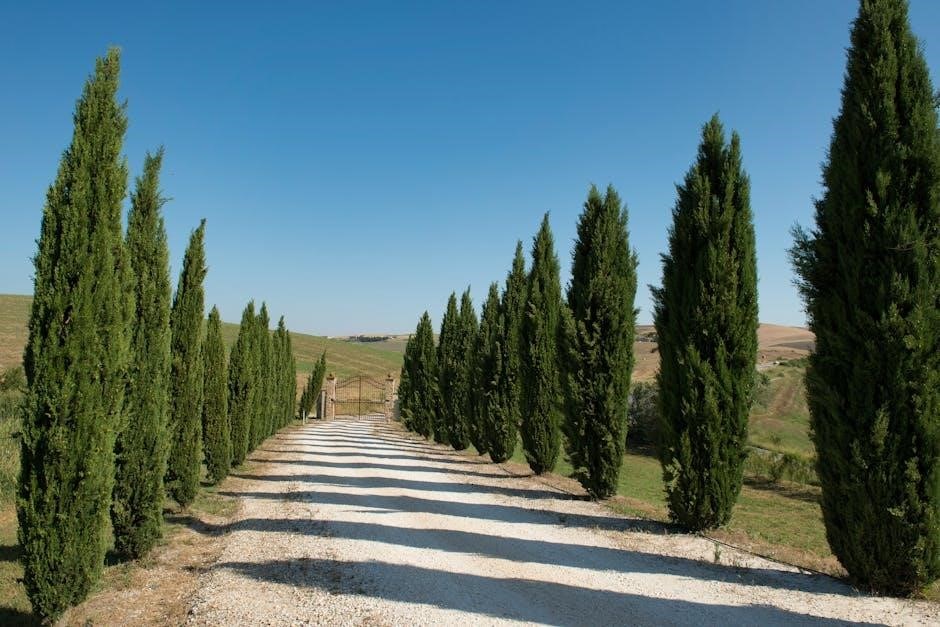
Wine on a Budget
Enjoy great wine without breaking the bank․ Explore affordable options‚ shop during sales‚ and try lesser-known labels for quality and value․ Perfect for beginners!
Best Affordable Wines
Discover excellent wines at budget-friendly prices․ Vinho Verde and Pinot Grigio offer crisp‚ refreshing profiles․ Merlot and Prosecco are smooth and versatile․ Shop during sales or explore subscription services for great deals․ Consider labels like Chateau Saint Michelle Riesling or Cupcake Chardonnay‚ which are both affordable and enjoyable․ These wines are perfect for beginners‚ offering quality without breaking the bank․ Explore lesser-known regions for hidden gems that deliver exceptional value and flavor․
Where to Shop for Wine
Find great wines at local grocery stores‚ specialty wine shops‚ or online retailers like Total Wine & More․ Explore wine subscription services for curated selections․ Many stores offer tasting notes and recommendations to help beginners choose․ Look for sales or discounts to discover affordable options․ Online platforms often provide detailed descriptions and customer reviews‚ making it easier to select wines․ Shopping at local vineyards or wineries can also offer unique‚ budget-friendly choices tailored to your taste preferences․
Wine Subscription Services
Wine subscription services are a fantastic way to explore new wines without the hassle․ They offer personalized selections based on your preferences‚ delivering wines to your doorstep․ Many services provide tasting notes and pairing tips‚ helping you learn as you go․ This convenient option allows you to expand your wine knowledge and discover new favorites from around the world with flexibility and exclusive access․
Embark on your wine journey with confidence! Start with approachable wines‚ experiment with pairings‚ and explore new regions to enhance your palate and enjoyment of wine․
Final Tips for Wine Beginners
Start with smooth‚ fruity wines like Merlot or Pinot Grigio․ Experiment with food pairings to enhance your experience․ Don’t stress about perfection—wine is subjective․ Use infographics or guides to learn styles and glasses․ Keep it fun and explore new regions; Remember‚ the best wine is one you enjoy․ Cheers to your wine journey!
Encouragement to Explore More
Embark on your wine journey with curiosity and enthusiasm․ Explore diverse regions and grape varieties to discover your preferences․ Start with smooth options like Merlot or Chardonnay‚ then venture into more complex wines․ Utilize guides‚ infographics‚ and online resources like Wine Folly to deepen your knowledge․ Remember‚ wine tasting is a personal adventure—trust your palate and enjoy the process․ Cheers to learning and savoring new experiences!
Additional Resources for Learning
Enhance your wine knowledge with guides like Wine for Beginners by Rebecca Thomas‚ offering practical insights․ Explore online platforms like Wine Folly for infographics and expert tips․ Join communities such as Reddit’s r/wine for shared experiences and advice․ Utilize apps like Vivino for wine reviews and recommendations․ Check out YouTube channels dedicated to wine education for visual learning․ These resources will help you navigate the world of wine with confidence and curiosity․